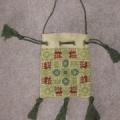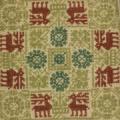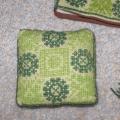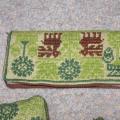You are here
Embroidered Bag, Pin Cushion, and Needlecase
For Lady Anna de Wilde
I began working on this some time in about 2003-2004, when I came across the pattern in a German embroidered sampler in a book of the V&A Museum’s sampler collection. The 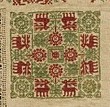 original
original  sampler can be viewed online here. I completed the embroidery side of the project around 2006-2007, and wrote up most of the documentation below in July 2010. I completed redrafting the patterns in August 2012.
sampler can be viewed online here. I completed the embroidery side of the project around 2006-2007, and wrote up most of the documentation below in July 2010. I completed redrafting the patterns in August 2012.
The patterns that I actually used from the sampler are the two pictured here.
Drafting the Pattern
At the time I took the book out of the library, I made a black and white photocopy of the page I liked. This is what I used to draft the two patterns from. The image was only about three inches square, so was really difficult to work with. Basically, I got some graph paper and coloured in squares to recreate the pattern. I went through several iterations of this, until I had what I felt was an accurate rendition. Several years later, I also drafted the larger deer and acorn motif that is further up the sampler. However, in drafting this, I kept it to scale with the original pattern.
Recently, I learnt to use a very clever programme called Inkscape, and, combined with the ability to download high resolution images from the V&A, I was able to go back and check my work (it was 99% accurate, I was thrilled). Having access to a high resolution image of the original sampler also enabled me to confirm my suspicion: the secondary pattern was in fact using elements that were exactly the same, just stitched at twice the scale.
Looking at the original sampler I realised that the colours that I had remembered weren't the colours that the original piece was actually stitched in - but I quite liked my version - so I produced patterns worked in the colours of the original sampler, and my own variants.
My pattern for the original square pattern can be found here, the pattern in my colourway is here. The rectangular pattern - both the original version and my colourway version - is on one document, here.
Making the Pieces
When I started on this, it was relatively early in my SCA career. These days, I don’t know that much, but I know a lot more than I did then.
At the time, I conveniently had some Medici embroidery wools in appropriate colours, so decided to do the embroidery using those wools. Shortly after I started, Medici stopped making their embroidery wool, and halfway through the first side, I realised I was going to run out of the pale green. Some words were said, but I’m not going to repeat them here as they might be considered Impolite for Wellbred Young Ladies1, and they pop up when you least expect them2. At that stage, I didn’t have any access to other embroidery wools, so I substituted in a brighter green. Later, I found an appropriate Appleton’s substitute, but of course there is still some variation in the colours across the pieces.
Fortunately for me, after I was able to access the high resolution image of the sampler I just discovered that I was being extremely authentic. The original piece is also worked in at least two shades of green, and the green used is different between the larger square piece and the secondary rectangular piece.
I also conveniently had some light green linen, and decided that this would be most suitable for the job. After all, it would save embroidering the background. I also decided to use cross stitch, because that seemed appropriate to the pattern. After looking at some 40-60 extant bags (mostly from France, Germany, and England, from the late 15th to mid 17th century), it turns out that I should probably have embroidered the background as well. A lot of extant bags appear to be completed in tent stitch, however, since the original piece I was working with was mostly completed in cross stitch, I decided to work mine in cross stitch also.
Incidentally, there are a rather large number of mistakes in the actual work, not the least of which is that if you look at the direction of the stitches, they change as you move from motif to motif. This is because it was much easier to work each similarly-placed motif moving out from the centre, turning my work as I went. I don’t have much patience and am a bit slack when it comes to embroidery, hence the direction of my stitches remained the same while the orientation of the fabric didn’t. Examining the original piece more closely, I again discovered that actually, I was just being extremely authentic in my work - the stitches on the original piece change direction throughout as well, so I wonder if the worker might have done the same thing that I did. Actually, my piece is slightly better worked, because all the stitches are complete crosses - there are small sections on the original where only half the stitch has been worked.
Completing the bag, I made eyelets at the top using buttonhole stitch. I lined the bag in a closely-woven brown linen that matched the colour of the deer quite nicely. I used a green crochet cotton that matched the colour of the flowers to make a fingerloop braid drawstring and handle, and also tassles for the bag. These days I would use silk, but that's only because I now have far easier access to it than I did then. The tassle placement was based on extant bags.
Completing the pincushion, I worked a matching fingerloop braid around the edges. For the needlecase, I lined it with the brown linen, and filled it with cream wool felt. I have no historic basis for the needlecase, but wanted to work that second piece as well and thought that a needlecase would be useful anyway.
Documentation
Originally I was just going to make a bag, but at some stage I decided I wanted to make a set of bag and pincushion, similar to the two below from the V&A Museum3 (there are quite a few like this that survive).
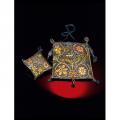
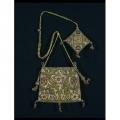
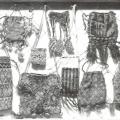 When I decided a year or two after finishing the purse (I can’t remember where I was at on the pincushion and needlebook), I became very worried that it Wasn’t Period and Wasn’t Right. The sampler was made (or finished?) in 1618, which is a singular generational removal from 1600. Depending on if the worker made it using a pattern book, or copying from someone else’s sampler, it’s fairly possible that it may have existed as a design prior in or before 1600.
When I decided a year or two after finishing the purse (I can’t remember where I was at on the pincushion and needlebook), I became very worried that it Wasn’t Period and Wasn’t Right. The sampler was made (or finished?) in 1618, which is a singular generational removal from 1600. Depending on if the worker made it using a pattern book, or copying from someone else’s sampler, it’s fairly possible that it may have existed as a design prior in or before 1600.
The “It’s Not Right’ conundrum got solved fairly easily by deciding to look at some extant German purses instead of English ones, since the sampler is of course German. Going back and looking at some relic pouches that are actually from the 14th century4, you can see that there is actually already a tradition of more geometric designs in place.
The finished pieces
Here are some images of the finished pieces that I made:
1 If you think I fall into this category, then you obviously don't know me all that well.
2 The words, that is, not the Wellbred Young Ladies. Although, you never know....
4 From this site.
- Log in to post comments
